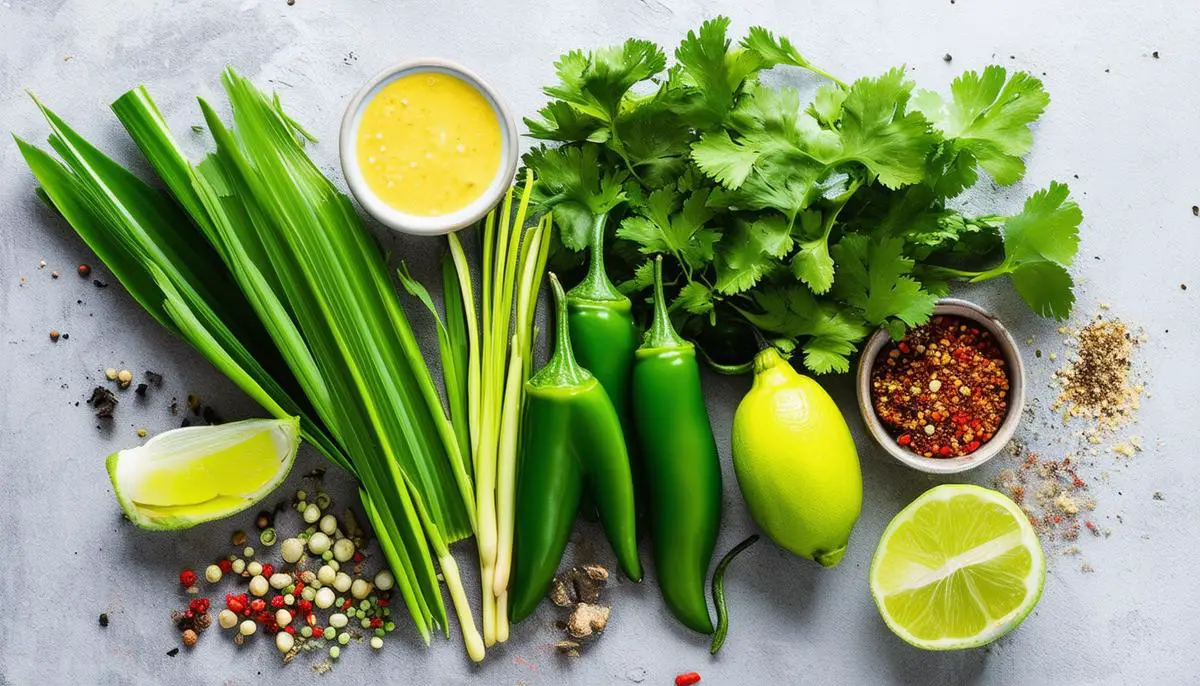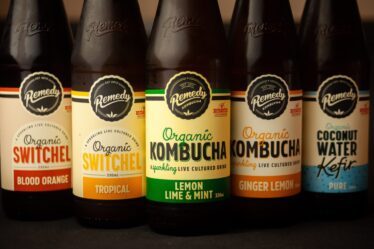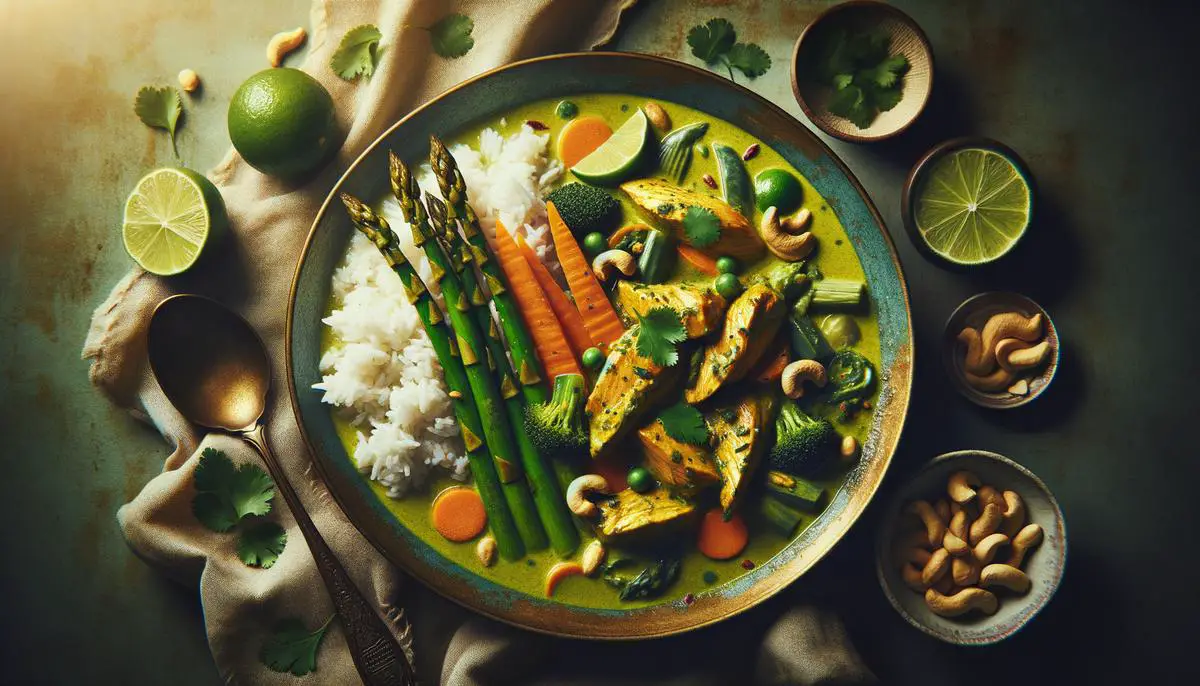
Background on Thai Green Curry
Thai Green Curry, known as Gaeng Keow Wan in Thai, is a vibrant burst of flavors and aromas that captures the essence of Thai culture. This curry harmonizes the hot, sour, sweet, and salty tastes into one tantalizing dish.
The heart and soul of Thai green curry lie in its carefully crafted paste, traditionally made from an array of fresh, potent ingredients. Zesty lime juice, fragrant basil, fresh cilantro, lemongrass, and fiery green chiles combine with garlic, shallots, and the distinctive aroma of makrut lime leaves to create a harmonious blend. Toasted coriander seeds, cumin seeds, and a dash of fish sauce further enrich this aromatic mixture.
Green curry's ability to marry heat with layers of freshness is unparalleled. The soothing, rich broth from the coconut milk is accented with the fresh zing of citrus and herbs. Bites of tender chicken or tofu and crisp vegetables elevate the dish, creating a perfect balance of textures and flavors. The subtle sweetness from coconut milk and palm sugar whispers through the savory depths, ensuring every spoonful runs the gamut of taste sensations.
For those without access to diverse, sometimes elusive ingredients, Thai green curry powder offers a pragmatic alternative. Although the herbal vibrancy of the traditional paste is unmatched, the powder can rapidly be reconstituted into a paste, greatly simplifying the process. Mix the powder with coconut milk, a splash of lime juice, and perhaps a hint of fish sauce to craft a dish that pays homage to traditional flavors while accommodating modern-day kitchens.
Thai green curry, regardless of how it's made, remains an ambassador of Thai cuisine's boundless potential. By adapting to make it accessible, whether through fresh paste or convenient powder, this aromatic, flavor-packed delight finds its way to every table, continuing to share its rich cultural and historical narrative with the world.
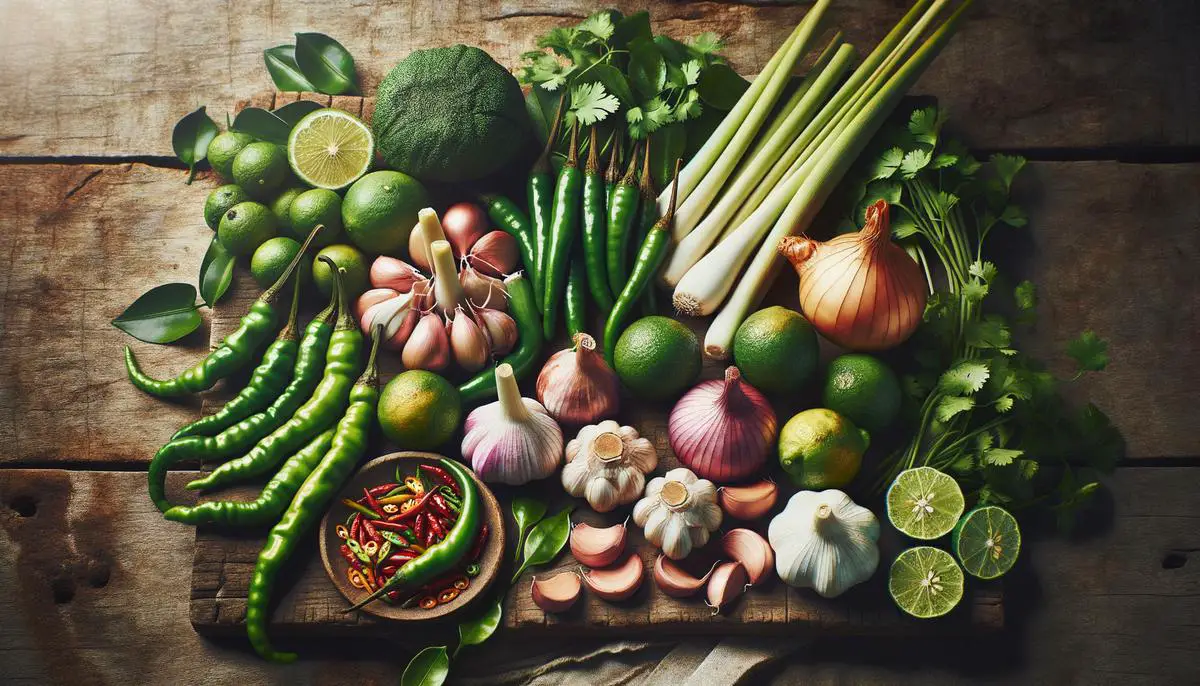
Key Ingredients in Thai Green Curry Powder
High-quality Thai Green Curry Powder is a carefully balanced blend of several potent ingredients, each contributing to its distinctive flavor profile:
- Lime Peel: Provides a bright, citrusy aroma that adds a layer of freshness, counterbalancing the richness of coconut milk.
- Galangal: A close relative of ginger, it imparts a sharp, peppery flavor with a hint of citrus, deepening the earthy undertones.
- Lime Leaves (Makrut Lime Leaves): Bring an intense citrus fragrance that is critical to authenticity, lending a complex, aromatic quality that binds all the flavors together.
- Green Serrano Chiles: Offer both heat and color, contributing to the vibrant green hue and a moderate heat level.
- Cilantro: Both the leaves and stems are used for their fresh, herbaceous flavor, adding a green, zesty brightness.
- Basil (Thai Basil): Introduces a slight anise or licorice note, enhancing the herbal complexity.
- Shallots: Provide a subtle sweetness and a mild onion flavor, creating a depth that enriches the overall profile.
- Lemongrass: Has a lemony, gingery flavor that is both fragrant and slightly astringent, bringing a unique freshness and zesty lemon undertone.
- Garlic: Adds a foundational savory base with its pungent, aromatic quality, enhancing the umami profile and balancing sweetness and acidity.
- Cumin Seeds: When toasted, they offer a warm, earthy aroma with notes of lemon and nuttiness, deepening the flavor complexity.
- Coriander Seeds: Contribute a floral, citrusy flavor that pairs well with the other spices, adding a subtle, sweet warmth when toasted.
- White Pepper: Distinguished by its earthy, musty flavor, it adds a mild heat and an almost wine-like fermentation quality.
- Black Pepper: Adds a sharper, more pungent heat compared to white pepper, providing a dynamic spiciness.
- Fish Sauce: Although not included in the powder, a splash in the final curry adds necessary umami and depth. For a plant-based alternative, soy sauce or tamari can be used.
- Lime Juice Powder: Infuses the blend with concentrated citrus notes, enhancing the overall tanginess and lifting the flavors.
Each component plays a critical role in creating a balanced, vibrant, and authentically flavored curry. Together, they form a layered, harmonious combination that captures the essence of traditional Thai cuisine.
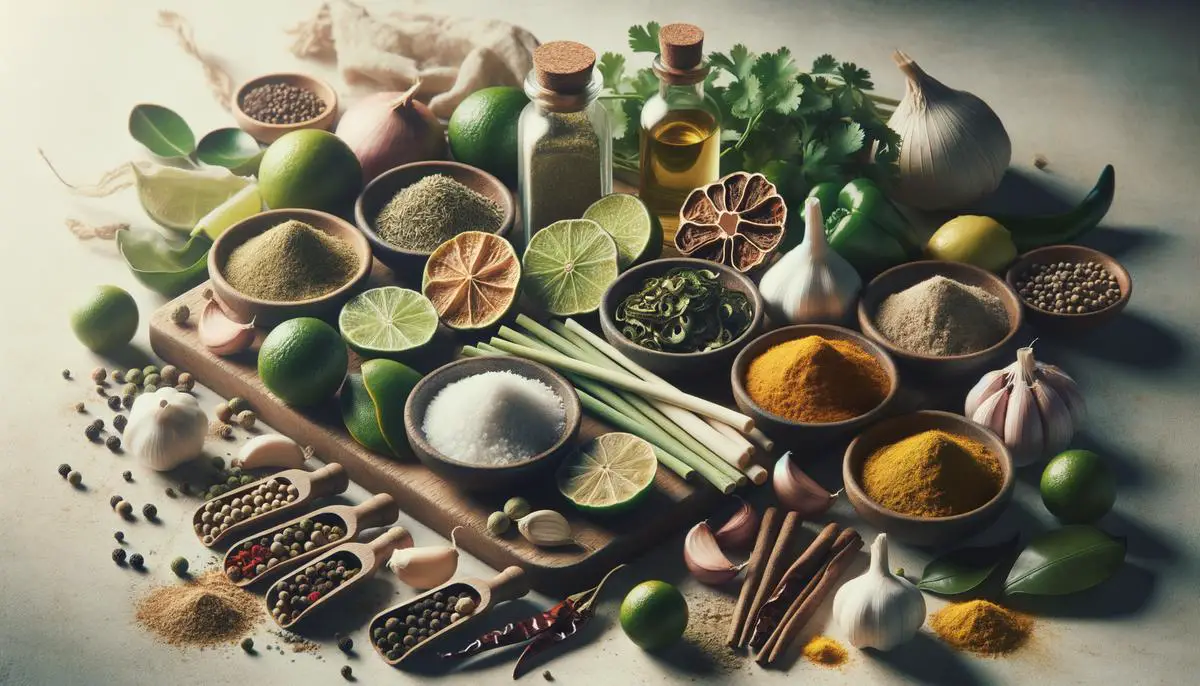
Versatility of Thai Green Curry Powder
Thai Green Curry Powder isn't limited to the traditional green curry dish. Its vibrant and complex flavor profile opens a world of culinary options, transforming everyday recipes into dishes with a Thai twist. Here are some innovative ways to use it:
Marinades for Chicken: Mix the curry powder with fish sauce, lime juice, and a bit of oil to marinate chicken for a few hours before grilling or roasting. The result is tender, flavorful meat with an exotic flair.
Seasoning for Mussels: Create a sauce by sautéing garlic, shallots, and the curry powder. Add coconut milk and let it simmer. Introduce the mussels, covering them until they open and are infused with the delightful curry essence. Serve with crusty bread to soak up the delectable sauce.
Salad Dressings: Combine the curry powder with lime juice, olive oil, honey, and salt for a quick and exciting vinaigrette. This unique dressing can elevate simple greens, adding a burst of flavor that is both refreshing and spicy.
Substitute for Indian Curry Powder: Experiment with substituting Thai Green Curry Powder in recipes that traditionally call for Indian curry powder. This can provide an interesting Thai twist to dishes such as chicken curry, lentil stew, or roasted vegetables.
Stir-Fry: Add a teaspoon of the curry powder to stir-fries with soy sauce, lime, and fish sauce for a quick and flavorful sauté of vegetables and protein. This works particularly well with shrimp, tofu, or beef.
Soups: Incorporate Thai Green Curry Powder into coconut-based soups. Begin with a base of coconut milk, add the curry powder and simmer with broth, vegetables, and tofu or chicken for a warm and comforting dish with an exotic touch.
Rice Dishes: Stir a small amount of curry powder into rice as it cooks, adding a fragrant quality and subtle heat. Green curry rice pairs exceptionally well with grilled meats or spicy sides.
By exploring these creative uses, Thai Green Curry Powder can become a staple that brings versatility and vibrant flavors to your culinary repertoire, encouraging experimentation and creativity.

Tips for Using Thai Green Curry Powder
To fully harness the potential of Thai Green Curry Powder, understanding its application can make a significant difference in your culinary results. Here are some practical tips:
How to Mix Thai Green Curry Powder into a Paste
Transform the powder into a paste for an authentic taste by blending it with a few staple ingredients:
- Coconut Milk: Use full-fat coconut milk to create a rich, creamy base.
- Fish Sauce: A few tablespoons can add depth and umami. For a vegetarian alternative, use soy sauce or tamari.
- Lime Juice: Fresh lime juice brightens the paste, balancing the richness of the coconut milk.
- Garlic and Ginger: Adding freshly minced garlic and ginger can enhance the fresh flavor profile.
- Sugar: A pinch of coconut sugar or palm sugar can help balance out the heat and acidity.
Combine these ingredients in a bowl and stir until smooth. This paste can be used immediately or stored in the fridge for quick weeknight meals.
Marinating Proteins
Marinating proteins with Thai Green Curry Powder can impart a robust flavor before cooking:
- Chicken: Combine the curry powder with coconut milk, lime juice, and fish sauce. Allow the chicken to marinate for at least two hours, ideally overnight.
- Tofu: For a vegetarian option, marinate firm tofu in a mixture of curry powder, soy sauce, and sesame oil for an hour.
- Seafood: Shrimp or fish fillets can be marinated briefly in the curry powder, lime juice, and coconut milk for 30 minutes.
Cooking Methods to Maximize Flavor
The cooking method you choose can greatly impact the final flavor:
- Sautéing: Heat the curry paste in oil until fragrant to caramelize the ingredients and release the essential oils. Then add your proteins and vegetables.
- Simmering: After sautéing, simmer your dish in coconut milk to cook the ingredients thoroughly and allow the flavors to meld together.
- Grilling: If you've marinated meats or vegetables, grilling can lend a smoky depth that complements the spicy and herbal notes.
Substitution Suggestions for Vegetarian or Vegan Versions
- Fish Sauce: Replace with soy sauce, tamari, or a vegan fish sauce to retain the salty, umami elements.
- Meat Proteins: Substitute with hearty vegetables like eggplant, mushrooms, or tofu for a satisfying texture.
- Broth: Use vegetable broth or dried shiitake soaking water instead of chicken broth when diluting your curry paste.
By integrating these tips, you can make the most out of Thai Green Curry Powder, bringing a taste of traditional Thai cuisine into your kitchen with ease while ensuring the dishes remain flavorful, aromatic, and adaptable to various dietary preferences.
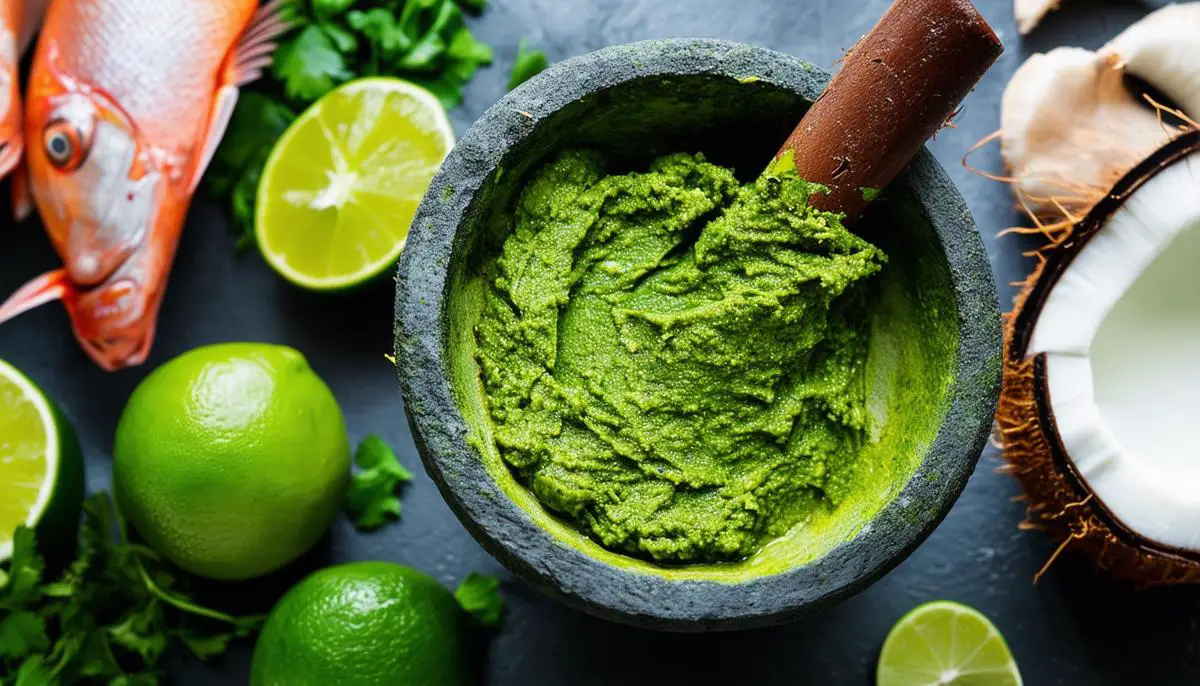
Recipe: Thai Green Curry Chicken
Ingredients:
- 2 tablespoons Thai Green Curry Powder
- 1 pound boneless, skinless chicken thighs, cut into 1-inch pieces
- 1 tablespoon fish sauce
- 1 teaspoon lime juice
- 1 tablespoon avocado oil or olive oil
- 1 can (13.5 ounces) coconut milk
- 1 tablespoon minced garlic
- 1 tablespoon minced ginger
- 1 yellow onion, thinly sliced
- 2 cups thinly sliced carrots (about 6 ounces)
- 2 cups trimmed and sliced asparagus (about 8 ounces)
- 2 teaspoons lime zest or 2-3 kaffir lime leaves
- 4 cups roughly chopped mixed greens (such as spinach or baby bok choy, about 6 ounces)
- Sea salt to taste
- Lime wedges, chopped cilantro, and chopped toasted cashews for garnish
Instructions:
- In a medium bowl, combine Thai Green Curry Powder, fish sauce, and lime juice. Add the chicken pieces and toss to coat. Marinate for at least 30 minutes, preferably up to 2 hours in the refrigerator.
- Heat the avocado oil in a large skillet or medium-sized pot over medium-high heat. Add the marinated chicken pieces and sauté until browned and just cooked through, about 5-7 minutes. Remove chicken from the skillet and set aside.
- In the same skillet, add the minced garlic and ginger. Sauté until fragrant, about 1-2 minutes.
- Add the sliced onion and carrots. Cook until the onions begin to soften, about 3-4 minutes.
- Stir in the lime zest or kaffir lime leaves, followed by the coconut milk. Bring the mixture to a gentle boil.
- Reduce heat to a simmer. Return the chicken to the skillet and add the asparagus. Simmer until the vegetables are tender but still crisp, about 5 minutes.
- Stir in the chopped mixed greens and cook until they are just wilted, about 1-2 minutes.
- Season to taste with sea salt.
- Serve the Thai Green Curry Chicken over steamed jasmine rice. Garnish with lime wedges, chopped cilantro, and toasted cashews. Adjust the spice level by adding more curry powder or a splash of lime juice if desired.
Nutritional information per serving:
Calories: 380
Fat: 22g
Carbohydrates: 18g
Protein: 32g
Sodium: 800mg
Fiber: 5g
Customization Options:
- Vegetable Choices: Use vegetables such as sugar snap peas, zucchini, or bell peppers in place of or in addition to the listed vegetables.
- Protein Alternatives: Substitute chicken with tofu, shrimp, or beef, adjusting cooking times accordingly.
- Spice Level: Modify the spiciness by increasing or decreasing the amount of Thai Green Curry Powder used in the marinade or the final dish.
Recipe: Thai Green Curry Paste
Ingredients:
- 2 teaspoons cumin seeds
- 2 teaspoons coriander seeds
- 3 small green chilies, seeded and chopped (adjust based on desired heat level)
- 1 medium green bell pepper, chopped (optional for milder curry)
- 5 cloves garlic, peeled
- 2 stalks lemongrass, chopped (only the pale yellow portions)
- 1 tablespoon fresh ginger, sliced (or galangal if available)
- 1 medium shallot, chopped
- Zest of 1 lime
- 4 makrut lime leaves, torn
- 1 bunch cilantro stems, roughly chopped (reserve leaves for garnishing)
- 1 tablespoon fish sauce (or soy sauce for vegan/vegetarian option)
- 1 tablespoon fresh turmeric, sliced (or 1 teaspoon ground turmeric)
- 3 tablespoons lemon juice
- 1 medium lime, juiced
- 2-3 tablespoons avocado oil or water
- 1 tablespoon maple syrup or coconut sugar
- 1/2 teaspoon sea salt (adjust to taste)
Instructions:
- Toast cumin seeds and coriander seeds in a small skillet over medium heat for 4-5 minutes, stirring or shaking often until fragrant and slightly darkened. Transfer to a mortar and pestle or spice grinder and loosely crush.
- In a food processor or blender, combine the toasted cumin and coriander with chopped green chilies, green bell pepper (if using), garlic, lemongrass, ginger, shallot, lime zest, makrut lime leaves, cilantro stems, fish sauce, turmeric, lemon juice, lime juice, avocado oil (or water), maple syrup (or coconut sugar), and sea salt.
- Blend until a smooth paste forms, occasionally scraping down the sides. The lemongrass can take time to grind, but be patient.
- Adjust seasoning by adding more lime juice for acidity, sea salt for flavor, or additional chilies for heat if needed.
- Store the paste in an airtight container in the refrigerator for up to 10 days or freeze in ice cube trays for up to one month.
